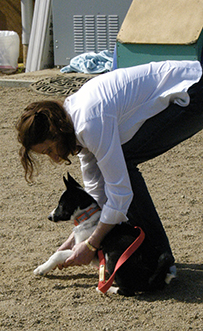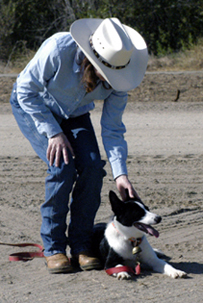Through our interest in search and rescue (SAR) training, I have been challenged to acquire handling skills that have immensely improved the relationship I have with my dogs. I thought I would summarize a few of those principles here, in the hope that they may help you to communicate better with your canine.
Don't ask, tell
How many times have you heard someone give their dog a command that sounds more like a question than a command? Your voice should not go up in pitch as you utter the words. That does not mean you should yell at your dog or express anger in your voice. Dogs have better hearing than humans, and you need not shout. Just give your command in an unhesitating, yet friendly, voice. If you are using repitition with your dog, ending each day's training on a success, your dog should consistently obey. If not, you may want to reconsider your training technique.

Above, I gave three-month-old California Karelian's Star the command for lay down while showing her what I wanted her to do.

Above, Star was very proud to get it right.
Time your reactions
Your dog needs to understand that you are in charge. Your dog should walk by your left side, not too far in front of you nor too far behind you. If you slow down, so should your dog. The dog's focus should be on your left knee. When you walk with your dog, vary your speed and stride, so your dog has to adjust with you. Don't let walking with your dog become a tug of war, where you are maintaining constant pressure on the leash. If your dog is getting ahead of you, make a sharp turn in either direction to get your dog's attention. Below, 5-month-old California Karelian's Star already knows how to walk along, off leash.

As you get to know your dog, you can anticipate undesirable behavior and correct immediately. You have lost the opportunity to correct your dog if the correction does not immediately follow the undesirable behavior.
Don't give your dog a command that you do not have the will to enforce. Your dog needs to learn from experience that you mean what you say, the first time you say it. End your training sessions before you exceed your dog's attention span, so you can end each and every session with successful behavior. Especially if you are teaching something new or your dog is young, train daily and limit each session to 3-5 minutes.
Entice, don't push
Using a "happy voice" to call your dog "here" when it has broken loose from its collar creates a sense of fun for your dog in complying with your request. You don't want your dog to shrink from you because it senses disapproval or worry in your tone of voice. If you want your dog to jump a hurdle, don't drag the dog up by the neck.
Below, instead of forcing your dog, get a running start and enourage the dog with an encouraging tone of voice. (Can you find the other Karelian Bear Dog in this picture?)

Reward for a full minute
Reward long enough to make a real impact. A full 60 seconds may seem like a long time, but you and your dog may accomplish more faster if you take time to enjoy the celebration of success. Make sure you give that reward only for a completed task. For example, if the goal is to have your dog locate a stranger and then return to you, don't say "good girl" until your dog comes all the way back to you.
Below, California Karelian's Star is being rewarded for laying down on command while she remains down. This teaches her to accept praise without being released from the down position.

Motivate your dog
We prefer not to reward with food. So, especially when teaching complex skills, we use a toy that our dog really loves and reserve that reward only for that training. Remember, reward success for a full minute, as discussed above.
Below, California Karelian's Star's reward is a furry squeak toy.

|